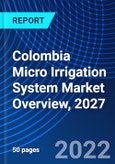10% Free customization
Micro irrigation systems are excellent for reducing water waste, reducing soil erosion, and boosting crop yields without using excessive amounts of water. Additionally, technological developments in the areas of data analytics and water flow will encourage adoption among both small-scale farmers and larger corporate farming operations. The traditional agricultural industry uses the majority of the water on earth; thus the use of water-efficient crop production irrigation techniques like micro irrigation is being pushed by the planet's diminishing water supplies. The use of drip and sprinkler irrigation systems in agriculture is expanding as more irrigation systems have been developed that work with a variety of crops, including orchard crops, cereals, oilseeds, and others. In addition, the government's subsidies for using this type of irrigation for crop production and the growing participation of private entities in the development of agricultural projects and systems are anticipated to have a beneficial impact on the segment's growth.This report comes with 10% free customization, enabling you to add data that meets your specific business needs.
1h Free Analyst TimeSpeak directly to the analyst to clarify any post sales queries you may have.
The market for micro irrigation systems is anticipated to experience rapid growth over the course of the forecast period, according to the research report Colombia Micro Irrigation System Market Overview, 2027. The market is anticipated to rise quickly due to the strong demand for micro-irrigation systems like sprinklers and drippers. The drip irrigation system market is expected to grow at a favorable rate during the forecasted period. Orchards and vineyards have been growing at a steady pace on account of the high demand from consumers in the country.
Farmers are switching from flood irrigation to micro-sprinkler systems as they become more aware of the benefits of this type of irrigation. Concern about flood irrigation's significant water loss and the resulting leaching is the main element driving this trend. Despite the high initial cost of installation, producers are encouraged to use sprinkler irrigation systems by the cost-effectiveness of the systems after two to three years and the accessibility of a variety of micro-sprinkler system parts. Flood irrigation's declining popularity is a result of its drawbacks, which include inefficient water consumption, an inability to irrigate hilly terrain, and unequal water distribution. Micro irrigation systems need constant care and maintenance. Emission devices may become clogged by algae, mineral impurities, and soil particles. There is a chance that rats, animals, and insects could harm some of the equipment. Sprinkler irrigation systems also require extra hardware for frost protection. If not identified and fixed in a timely manner, emitter clogging directly affects the rate and uniformity of water application, increases maintenance costs, and causes crop damage and production losses. Clogging issues caused by roots are also frequent. The cost of replacing parts could be high. A barrier to the market for micro irrigation systems is the cleaning of tubes and emitters, which increases the cost of these systems and takes into account farm circumstances after harvest.
The market was dominated by the category of orchard crops. This sort of irrigation is a suitable fit for these crops because many fruits, vegetables, and other horticultural crops need a particular atmosphere to thrive effectively. A globally increasing demand for high-value and cash crops is promoting the expansion of this sector. The segment's growth is being further accelerated by the high applicability of technologies like drip irrigation for the cultivation of different orchard crops, including tomatoes, bananas, beetroot, and others. Due to its effectiveness in drastically decreasing water loss while also yielding good crop yields, localized irrigation is increasingly used in the production of water-intensive field crops including soybeans, maize, and others. Additionally, it is projected that growing efforts by market participants to develop inexpensive and cost-effective solutions would aid in the expansion of the field crops segment throughout the course of the projection period.
Covid-19
COVID-19, followed by lockdowns across several economies is negatively influencing the agriculture industry, especially from the perspective of labor. The crisis is expected to continue in the upcoming months owing to suspended trade across economies at present. There is no doubt that the pandemic will affect the market negatively as well, however, to what extent can only be anticipated once the pandemic ends. Less labor associated with the operation of some of the micro irrigation practices, coupled with the availability of automated systems especially across the developed market is expected to remain the prominent reasons for the plausible market stability. the economic slowdown caused due to the COVID-19 can impact the number of annual installations of high-priced micro irrigation systems.Considered in this report:
- Geography: Colombia
- Base year: 2021
- Estimated year: 2022
- Forecast year: 2027
Aspects covered in this report
- Colombia Micro Irrigation market with its value and forecast along with its segments
- Various drivers and challenges
- On-going trends and developments
- Top profiled companies
- Strategic recommendation
By Irrigation Type:
- Drip Irrigation System
- Sprinkler Irrigation System
- Other Irrigation System (Bubbler,Spray etc.)
By Crop Type:
- Field Crops
- Orchards and Vineyards
- Plantation Crops
- Other Crops
Intended audience
This report can be useful to industry consultants, manufacturers, suppliers, associations & organizations related to Micro Irrigation Industry, government bodies and other stakeholders to align their market-centric strategies. In addition to marketing & presentations, it will also increase competitive knowledge about the industry.Table of Contents
1. Executive Summary3. Colombia Macro Economic Indicators5. Colombia Micro Irrigation System Market Trends10. Strategic Recommendations11. Disclaimer
2. Introduction
4. Colombia Micro Irrigation System Market Category Analysis
6. Colombia Micro Irrigation System Market Overview
7. Colombia Micro Irrigation System Market Segmentations
8. Colombia Micro Irrigation System Market Opportunity Assessment
9. Competitive Landscape
List of Figures
List of Table








